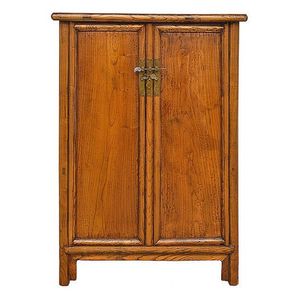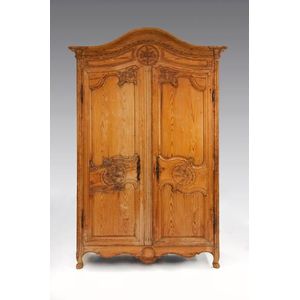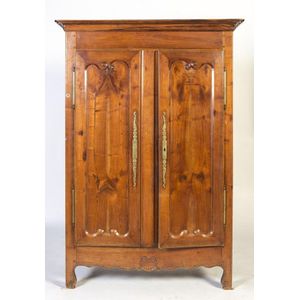Louis XV Carved Oak Armoire, 1770
You must be a subscriber, and be logged in to view price and dealer details.
Subscribe Now to view actual auction price for this item
When you subscribe, you have the option of setting the currency in which to display prices to $Au, $US, $NZ or Stg.
- Acanthus - A stylized leaf motif, one of the primary decorative elements of classical Greek and Roman architecture, derived from the genus of flowering plants in the family Acanthaceae, native to tropical and subtropical regions of the Mediterranean area. It is a common element in classical Greek and Roman design, and is often seen in Corinthian and Composite order columns and used as a decorative element in English, European and Australian furniture, particularly on the curve of a leg, and as decoration for a corbel.
- Frieze - An architectural term denoting the flat, shaped or convex horizontal surface of furniture, between the architrave and the cornice, usually found on a cabinet or bookcase, or on desks and tables where it may include drawers, the area between the top and the legs. In ceramics, the term refers to the banding, of usually a repeating pattern, on the rims of plates and vases.
- Cabriole Leg - The cabriole leg evolved from an elongated scroll, curving out at the knee which may or may not be carved, and forming a serpentine shape as it descends to the foot.
First introduced into English furniture in the late 17th century, cabriole legs were widely used during the Queen Anne and early Georgian periods, where they frequently terminated in a pad foot or ball and claw foot. The style has had many imitators since then. The cabriole leg was re-introduced in the mid-19th century, and is commonly associated with the balloon-back dining or drawing-room chairs made in walnut, mahogany or, in Australia, cedar. The Victorian cabriole leg, on the whole, was rather more slender than the earlier form, following the French style, which emphasized the delicacy and daintiness of the chairs they were designed to support. Cabriole legs are sometimes found on windsor chairs, especially those made during the 18th century. - Panels - Timber pieces, usually of well-figured wood either recessed or applied over the frames of doors and as decoration elsewhere in the carcase of cabinet furniture. The panels may take a variety of shapes rectangular, square, shield shape, oval, half-round or in the form of Egyptian pylons.
- Foliate - Decorated with leaves or leaf-like forms.
- Cornice - The upper section of a high piece of furniture such as a bookcase, wardrobe or cabinet that sits immediately on the main structure. The cornice is usually decorated with a variety of architectural mouldings, worked either with a moulding plane or, from the later 19th century, by machine. The front and side of the cornice are mitred together, strengthened by glue blocks, and the back is generally a simple dovetailed rail to hold the structure together. Cornices are generally, though not always, fitted separately to the piece and are held in place either by screws sunk into the top board or by wooden corner blocks. A pediment may sit above the cornice, but sometimes the terms cornice and pediment are used interchangeably.
- Circa - A Latin term meaning 'about', often used in the antique trade to give an approximate date for the piece, usually considered to be five years on either side of the circa year. Thus, circa 1900 means the piece was made about 1900, probably between 1895 and 1905. The expression is sometimes abbreviated to c.1900.
- Oak - Native to Europe and England, oak has been used for joinery, furniture and building since the beginning of the medieval civilisation. It is a pale yellow in colour when freshly cut and darkens with age to a mid brown colour.
Oak as a furniture timber was superceded by walnut in the 17th century, and in the 18th century by mahogany,
Semi-fossilised bog oak is black in colour, and is found in peat bogs where the trees have fallen and been preserved from decay by the bog. It is used for jewellery and small carved trinkets.
Pollard oak is taken from an oak that has been regularly pollarded, that is the upper branches have been removed at the top of the trunk, result that new branches would appear, and over time the top would become ball-like. . When harvested and sawn, the timber displays a continuous surface of knotty circles. The timber was scarce and expensive and was used in more expensive pieces of furniture in the Regency and Victorian periods.
This item has been included into following indexes:
- armoires 300
Visually similar items

A French provincial cherry wood sideboard, 18th century, 102 cm high, 126 cm wide, 54 cm deep

A Chinese elm Shangxi cabinet late 19th century the canted rectangular body with two doors, square supports, 89 x 134.5 x 45.5 cm, accompanied by a certificate of authenticity

A Louis XVI carved pine armoire, French, 18th/early 19th century. 225 cm high, 130 cm wide, 50 cm deep

A French provincial Cherrywood armoire with later cornice, 18th /19th century, 204 cm high, 142 cm wide, 68 cm deep
